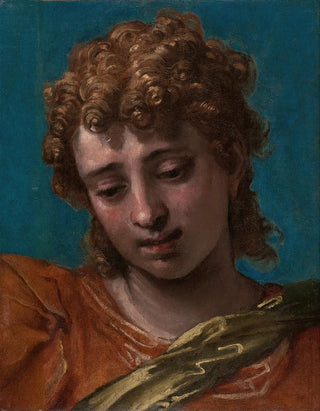Art print | Head of Saint Michael from the Petrobelli altarpiece - Paolo Véronèse Source: Reproduction | Tête de Saint Michel du retable Petrobelli - Paolo Véronèse


View from behind

Frame (optional)
In the vast panorama of art history, some works transcend their era to become symbols of a particular culture and spirituality. The art print Tête de Saint Michel du retable Petrobelli by Paolo Véronèse fits into this tradition. This piece, embodying both divine power and human beauty, captures the eye with its harmonious composition and masterful use of colors. Saint Michel, warrior archangel and protector, is depicted with an intensity that evokes both strength and serenity, inviting the viewer to contemplate not only the figure portrayed but also the spiritual message it conveys.
Style and uniqueness of the work
The Tête de Saint Michel stands out for its baroque style, characterized by dynamic forms and striking expressiveness. Véronèse, a master of color and light, employs bold contrasts to bring his subject to life. The golden hues that envelop the angel’s face evoke celestial light, while delicately placed shadows add psychological depth to the piece. The way Saint Michel’s features are sculpted with almost tactile precision demonstrates the artist’s technical skill. Every detail, from the piercing gaze to the folds of the drapery, is carefully crafted to enhance the impression of movement and vitality. This attention to detail, combined with a balanced composition, makes this work a true masterpiece that continues to fascinate art enthusiasts.
The artist and his influence
Paolo Véronèse, born in 1528 in Verona, is one of the emblematic figures of the Italian Renaissance. His work is characterized by a rich chromatic palette and a talent for capturing the splendor of religious and mythological scenes. Influenced by Titian and Tintoretto, Véronèse developed a personal style that combines grandeur with intimacy. His work on the Tête de Saint Michel from the Petrobelli altarpiece perfectly illustrates this duality. By integrating elements of Christian tradition while adding a touch of theatricality, he managed to touch generations of viewers. The impact of his art extends beyond

Matte finish

View from behind

Frame (optional)
In the vast panorama of art history, some works transcend their era to become symbols of a particular culture and spirituality. The art print Tête de Saint Michel du retable Petrobelli by Paolo Véronèse fits into this tradition. This piece, embodying both divine power and human beauty, captures the eye with its harmonious composition and masterful use of colors. Saint Michel, warrior archangel and protector, is depicted with an intensity that evokes both strength and serenity, inviting the viewer to contemplate not only the figure portrayed but also the spiritual message it conveys.
Style and uniqueness of the work
The Tête de Saint Michel stands out for its baroque style, characterized by dynamic forms and striking expressiveness. Véronèse, a master of color and light, employs bold contrasts to bring his subject to life. The golden hues that envelop the angel’s face evoke celestial light, while delicately placed shadows add psychological depth to the piece. The way Saint Michel’s features are sculpted with almost tactile precision demonstrates the artist’s technical skill. Every detail, from the piercing gaze to the folds of the drapery, is carefully crafted to enhance the impression of movement and vitality. This attention to detail, combined with a balanced composition, makes this work a true masterpiece that continues to fascinate art enthusiasts.
The artist and his influence
Paolo Véronèse, born in 1528 in Verona, is one of the emblematic figures of the Italian Renaissance. His work is characterized by a rich chromatic palette and a talent for capturing the splendor of religious and mythological scenes. Influenced by Titian and Tintoretto, Véronèse developed a personal style that combines grandeur with intimacy. His work on the Tête de Saint Michel from the Petrobelli altarpiece perfectly illustrates this duality. By integrating elements of Christian tradition while adding a touch of theatricality, he managed to touch generations of viewers. The impact of his art extends beyond






